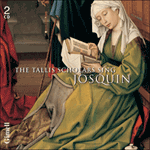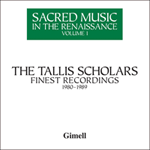
Welcome to Hyperion Records, an independent British classical label devoted to presenting high-quality recordings of music of all styles and from all periods from the twelfth century to the twenty-first.
Hyperion offers both CDs, and downloads in a number of formats. The site is also available in several languages.
Please use the dropdown buttons to set your preferred options, or use the checkbox to accept the defaults.

However, it was not Josquin’s idea in the first place to use these notes. According to Glareanus, writing in 1547 (Henricus Glareanus, Dodecachordon, 1547), they originated in mimicry of an unknown potentate who used to send away importunate suitors with the words ‘Lascia fare mi’ (‘Leave it to me’). Whether this is true or not, a number of popular songs of the time were written around the phrase. (In his entry on Josquin, in D.E.U.M.M. (Turin, UTET, 1985, Le biografie, II, p.472), Nino Pirrotta maintains that these five notes were inspired by the words ‘Lassa fare a mi/Non ti curare’ (‘Leave it to me, I’ll deal with it’), which begin a barzelletta attributed to Serafino Aquilano, a friend of Josquin. It appears that Aquilano’s humorous song alludes to Cardinal Ascanio Sforza, his protector, who was known for making promises he could not fulfil.) Apart from basing the tenor on it almost exclusively, Josquin was able to lend it to the other parts in his mass-setting by the technique of initial imitation, for instance in the ‘Christe’ and first ‘Hosanna’. The ‘Pleni sunt’ is imitative throughout. Only once (in the bass part at the end of the ‘Christe’) is the ostinato transposed to begin on D (subsequently necessitating a B flat). Otherwise, in more than two hundred repetitions, it starts on A or E. Perhaps the finest moment comes at the very end of the Agnus Dei (I and III) where the note-lengths of the ostinato become shorter and shorter as the mystical nature of the music intensifies.
from notes by Peter Phillips © 1986
Josquin ne fut cependant pas le premier à avoir l’idée d’utiliser ces notes. Selon Glareanus (Henricus Glareanus, Dodecachordon, 1547), elles ont pour origine l’imitation d’un potentat inconnu qui avait l’habitude de congédier les solliciteurs importuns avec les mots ‘Lascia fare mi’ (‘Laissez-moi faire’). Que cela soit vrai ou non, plusieurs chansons populaires de l’époque furent axées autour de cette phrase. (Dans l’article qu’il consacre à Josquin dans le D.E.U.M.M. (Turin, UTET, 1985, Le biografie, II, p.472), Nino Pirrotta maintient que ces cinq notes furent inspirées à Josquin par les premiers mots ‘Lassa fare a mi/Non ti curare’ (‘Laisse-moi faire, je m’en charge’) d’une barzelletta attribuée à son ami, Serafino Aquilano. Il semble que cette chanson drôle fasse référence à son protecteur, le cardinal Ascanio Sforza, qui était connu pour faire des promesses qu’il ne pouvait pas tenir.) Josquin put non seulement baser la partie de ténor presque exclusivement sur cette phrase, mais aussi la prêter aux autres voix de sa messe grâce à la technique de l’imitation initiale, par exemple dans le ‘Christe’ et le premier ‘Hosanna’. Le ‘Pleni sunt’ n’est qu’imitation du début à la fin. Une seule fois (la basse à la fin du ‘Christe’) l’ostinato est transposé pour commencer à ré (requérant par la suite un si bémol). Autrement, dans plus de deux cents répétitions, il commence au la ou au mi. Le plus beau moment se trouve peut-être à la fin de l’Agnus Dei (I et III) lorsque les notes de l’ostinato s’accourcissent à mesure que au fur et à mesure que s’intensifie le caractère mystique de la musique.
extrait des notes rédigées par Peter Phillips © 1986
Français: Michel Desforges
Josquin war freilich nicht derjenige, der als erster auf die Idee verfiel, diese Töne zu verwenden. Glarean berichtete 1547 (Glarean, Dodecachordon, 1547), daß sich dahinter die Worte “Lascia fare mi” (“Überlassen Sie das mir”) eines unbekannten Würdenträgers verbargen, der sich damit aufdringlicher Besucher entledigte. Gleichgültig, ob dies den Tatsachen entspricht oder nicht, eine ganze Reihe von Liedern der Zeit basiert auf diesen fünf Tönen. (In seinem Beitrag zu Josquin in D.E.U.M.M. (Turin, UTET, 1985, Le biografie, II, S.472) behauptet Nino Pirrotta, daß der Anfang einer “Barzelletta” von Josquins Freund Serafino Aquilano mit dem Titel “Lassa fare a mi/Non ti curare” (“Überlasse das mir/ich kümmere mich selbst darum”) Josquin zu dieser Phrase anregte. Anscheinend bezieht sich das witzige Lied Aquilanos auf seinen Gönner Kardinal Ascanio Sforza, der bekannt dafür war, gegebene Versprechen nicht zu halten.) Auch wenn das Tonmodell fast nur im Tenor vorkommt, so konnte Josquin es doch auch in den anderen Stimmen als Soggetto für die Anfangsimitation anderer Meßteile einsetzen, wie etwa im “Christe” oder im ersten “Hosanna”. Das “Pleni sunt” ist durchwegs kontrapunktisch im imitierenden Satz gestaltet. Lediglich ein einziges Mal, im Baß am Ende des “Christe”, setzt das immer wiederkehrende Modell transponiert auf D ein (was in der Konsequenz ein B nach sich zieht). Bei den mehr als zweihundert anderen Wiederholungen beginnt es auf A oder E. Die wahrscheinlich schönste Stelle findet sich ganz am Schluß des Agnus Dei (I und III), wenn die Notenwerte des Ostinato-Modells sich immer weiter verkürzen und dadurch die geheimnisvolle Wirkung dieser Musik noch verstärkt wird.
aus dem Begleittext von Peter Phillips © 1986
Deutsch: Gerd Hüttenhofer
Ad ogni modo, non fu Josquin ad avere avuto per primo l’idea di servirsi di queste note. Secondo Glareanus (Henricus Glareanus, Dodecachordon, 1547), esse sono originate dalla versione caricaturale e burlesca d’una tipica espressione d’un ignoto potente, il quale era solito congedare postulanti seccatori colle parole ‘Lascia fare mi’, cioè ‘Lascia fare a me, ci penso io’. Sia vero o no, rimane il fatto che all’epoca su questo motivo fu composto un certo numero di canzoni popolari. (Nino Pirrotta ritiene che il breve tema musicale di 5 note sia un ‘soggetto cavato dalle parole’ Lassa fare a mi/Non ti curare, incipit d’una barzelletta attribuita ad un compagno di des Prés, Serafino Aquilano, che l’avrebbe scritta alludendo probabilmente, e con bonaria ironia, al card. Ascanio Sforza, loro protettore, il quale pare facesse spesso promesse da marinaio. S.v. ‘Despres, Josquin’, in D.E.U.M.M., Torino, UTET, 1985, Le biografie, II, p.472.) Oltre che a basare su di esso pressoché esclusivamente il tenor, il nostro musicista riesce a prestarlo alle altre voci colla tecnica dell’imitazione iniziale (cioè appena esposte le primissime note del tema, senza aspettarne la conclusione), ad es. nel ‘Christe’ e nel primo ‘Osanna’. Nel ‘Pleni sunt’ l’imitazione è impiegata da cima a fondo. Solo una volta (nella parte del bassus alla fine del ‘Christe’) l’ostinato vien trasportato al re (che subito dopo ha bisogno d’un si bemolle); altrimenti, in più di 200 ripetizioni, esso principia sul la o sul mi. Forse il momento più bello arriva giusto alla fine dell’Agnus Dei (I e III), dove le note dell’ostinato s’accorcian sempre più man mano che si fa più intensa la natura mistica della musica.
Peter Phillips © 1986
Italiano: Bruno Meini
 Josquin: The Tallis Scholars sing Josquin Josquin: The Tallis Scholars sing Josquin"If one were looking for a superstar among Renaissance composers then Josquin is unquestionably the front runner. He was a star in his lifetime and he has become a star again more recently, aided in part when the recording of the two Masses on the ...» More |
 Sacred Music in the Renaissance, Vol. 1 Sacred Music in the Renaissance, Vol. 1The first of three volumes featuring The Tallis Scholars' finest recordings, one for each decade, and each offering over five hours of the award-winning performances that helped establish Renaissance Polyphony as one of the great repertoires of we ...» More |

